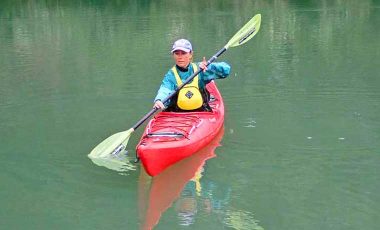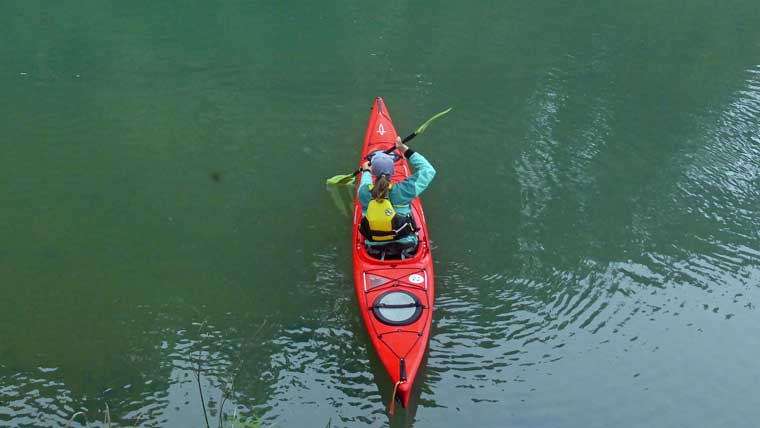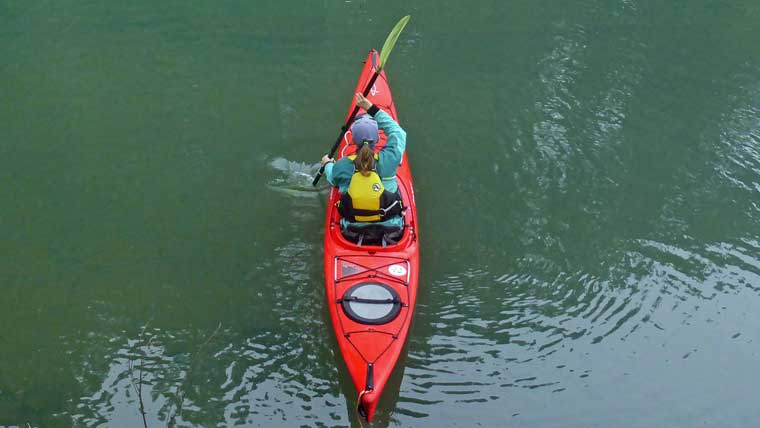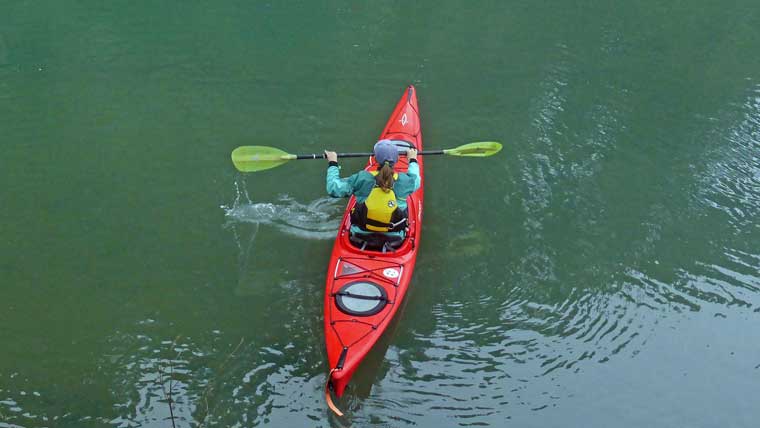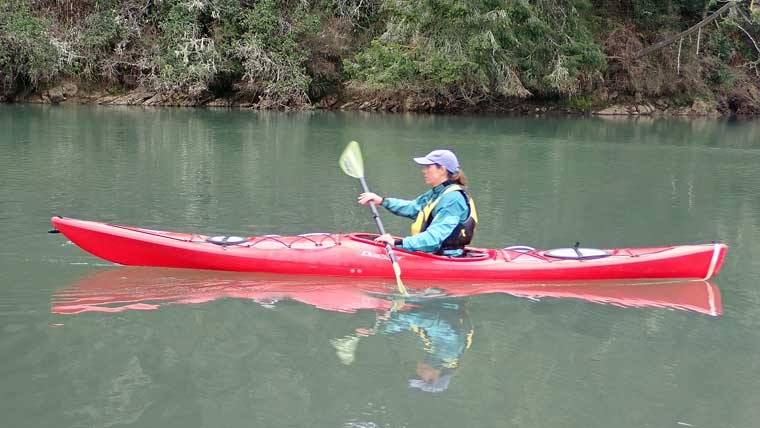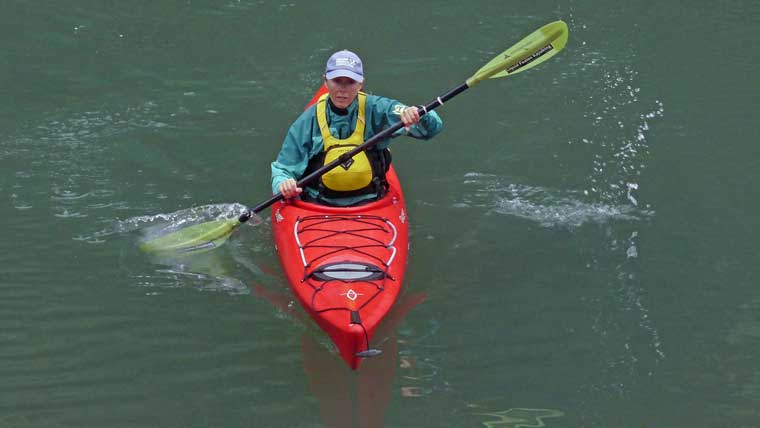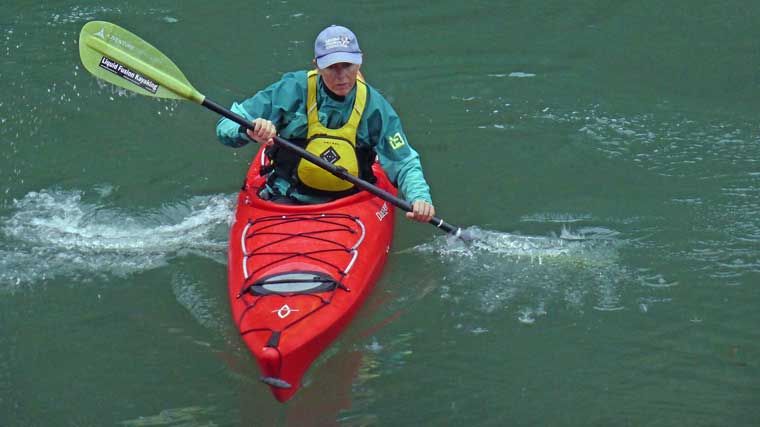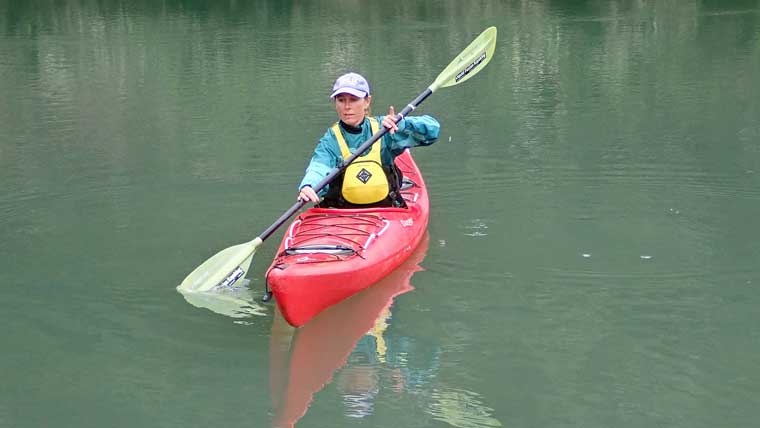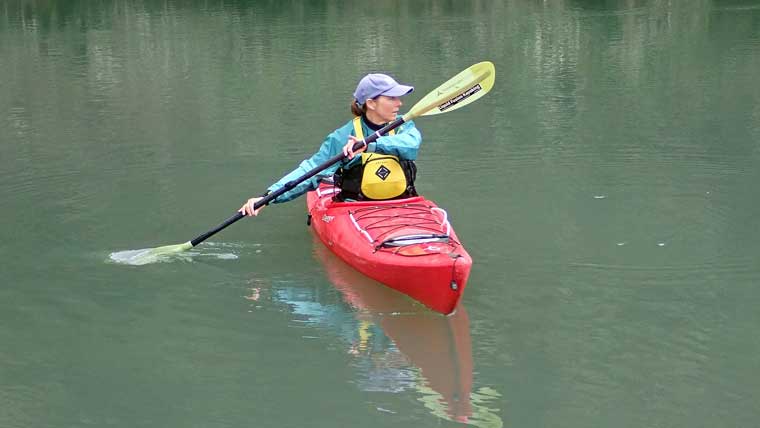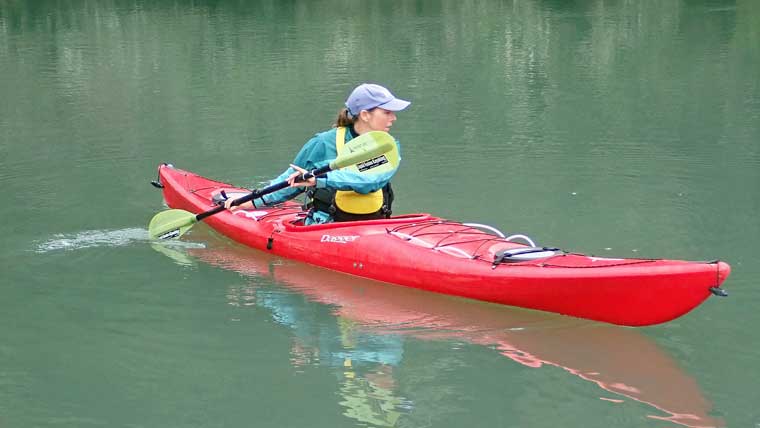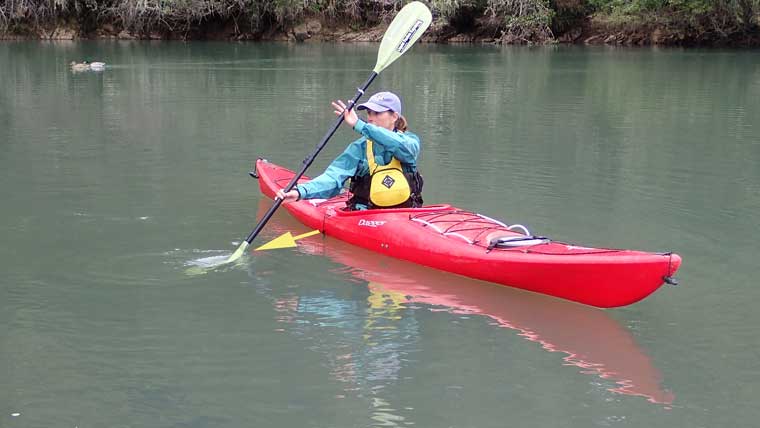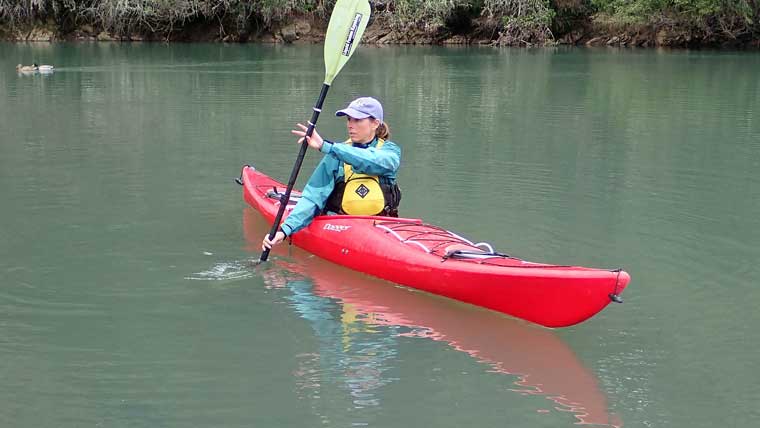Kayaking is a fun way to explore waterways and see the world from a different perspective. A great way to try kayaking is to go on a guided tour that includes basic instruction and all the necessary equipment. If you have tried kayaking and have decided to take up the sport, this article is designed as an introduction to equipment and basic skills. Taking a class or lesson from a reputable instructor will accelerate your learning of the basics and give you a foundation and resource for when you want to move beyond the basics.
Safety on the water is key. It is important to know the limitations of your craft and personal skills. All kayaks capsize. Knowing what to do when a capsize happens is just as important as knowing how to paddle a kayak. Weather and water conditions can change quickly. Awareness of the conditions and the weather forecast helps with good decision making. When in doubt, don’t go out.
Equipment for kayaking
At a minimum, you will need a kayak, paddle, and buoyancy aid.
Kayaks
There are many different types of kayaks. Taking the time to choose the correct kayak will make the sport more enjoyable. Buying a kayak is like buying a pair of athletic shoes. Considerations should be made regarding size, type, features, and quality. For example, wearing flip flops that are 2 sizes too big or too small on a rugged hiking trail can be done but isn’t usually the safest or most comfortable option.

Before buying a kayak, determine where you want to paddle then see what types of kayaks and equipment the local kayak outfitters are using. Taking a kayak for a test drive before you buy it is a great way to see if you like the way it fits and performs. Look for outfitters and kayak shops that have tours, classes, rentals, or demo days where you can try out different kayaks.
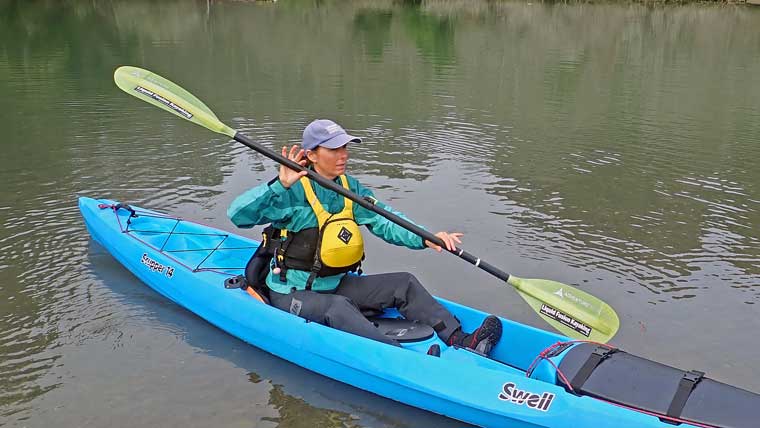
How to sit in a kayak
- Sit up straight and tall with a slight bend in the knees
- Keep your nose over your belly button
- Adjust your seat and feet to support sitting up straight
Common mistake
Leaning back in the seat like a recliner. Sit up straight. You will be more stable and efficient, and your lower back will thank you for it later. When you need to take a break, hinge forward to rest your back.
Paddles
Paddles are made from a variety of materials and come in a variety of lengths and shapes. Paddle length and shape is determined by the type of paddling you are doing. Typically the wider the kayak, the longer the paddle.
How to hold a paddle for kayaking
- Wide and loose grip
- Both hands equal distance from the blades
- Both arms fairly straight
Common mistakes
- Gripping the paddle tightly. Wiggle your fingers as you paddle to loosen your grip. This prevents blisters and tension.
- A narrow grip. Use a wide grip that is shoulder distance or wider for more power in your stroke.
Life jackets / buoyancy aids for kayaking
Wear a Coast Guard approved buoyancy aid or life jacket that fits properly and has a whistle. Shop around and try on different life jackets to find one that fits and is comfortable.
How to wear a buoyancy aid / life jacket
- Clip in the bottom buckle.
- Zip up the front or side zipper.
- Cinch in the side straps.
Common mistake
Not clipping the bottom buckle. The bottom strap is key for keeping the life jacket in place which makes for more comfortable paddling and effective if you end up in the water.
How to paddlle a kayak: basic paddle strokes
Go slow at first with deliberate attention to your body mechanics. As you progress, you will be faster and more efficient. Make sure that you are sitting up straight with your nose over your belly button and slight bend in your knees. Listen to your body. If it hurts, it is wrong.
Outlined here are the key points for paddling a kayak. As you progress, you can refine your technique to become more efficient.
Paddling forwards: the forward stroke
The forward stroke is the most common stroke. Spending time developing an efficient forward stroke will enable you to go farther and faster with less effort.
- Look where you want to go
- Anchor the blade in the water by your foot
- Pull the blade toward your hip
- Slice the blade out of the water before it reaches your hip
- Repeat on other side and continue alternating until the destination is reached
Common mistakes
- If your kayak is not going straight, make sure that you are looking where you want to go. Choose a stationary object (tree, rock, ect) and focus your vision on it as you paddle toward it. Beginners often look at each stroke which puts them off course. As you get more seat time, you will automatically adjust the length of each forward stroke slightly so that you are continually correcting your course.
- If your arms are getting tired, you are probably bending your arms too much. It will look like you are bicycling with your arms. Try keeping your arms straight and pushing with the foot on the same side that you are taking a stroke.
Paddling backwards: the reverse stroke
Just like driving a car, sometimes going backwards gets us where we want to be. Regularly paddling backwards is a good habit to develop because it will help to balance the muscles that tend to get over used from forward paddling.
- Look behind before starting to paddle backwards
- Anchor the blade behind your hip
- Sweep the blade toward the hip
- Slice the blade out of the water at the hip
- Repeat on the other side and continue alternating until you reach your destination
Common mistakes
- Leaning back when you paddle. Leaning back places stress on the lower back, disengages the core muscles, and decreases stability. Make sure you are sitting up straight when reverse paddling.
- Not going straight. Be patient. It takes lots of practice to proficiently paddle backwards. Try shorter strokes and focusing your vision on something straight in front of you to stay on course.
Stopping a kayak
Kayaks are not equipped with brakes, but you can use your paddle to effectively stop your kayak. To stop use powerful, short, choppy, strokes opposite the direction of travel.
- Going forward – do 3 -4 powerful, short, choppy reverse strokes on alternate sides.
- Going backward – do 3-4 powerful, short, choppy forward strokes on alternate sides.
Common mistake
- If your kayak is turning, you are not alternating sides or your strokes are too long.
- If you are off balance or feel unstable, make sure that you are sitting up straight with your nose over your belly button during the strokes.
Turning a kayak: the sweep stroke
Forward and reverse sweep strokes can be used to turn the kayak. The forward sweep helps keep forward momentum. The reverse sweep decreases momentum and is useful for quick direction changes. For both strokes remember to look where you want to go.
Forward sweep
- To go left, use the right blade (to go right, use the left blade)
- Anchor the blade in the water at your toes
- Sweep the blade WIDE and SLOW toward the rear of the kayak.
- Slice the blade out of the water
- Repeat if necessary
Reverse sweep
- To go left, use the left blade (to go right, use the right blade)
- Anchor the blade in the water behind your hips as close to the kayak as possible
- Sweep the blade WIDE and SLOW toward the front of the kayak
- Slice the paddle out of the water
- Repeat if necessary
Common mistakes
- Not anchoring the blade. Go slow and bury the blade in the water before starting to sweep.
- Hands are too high making for a deep stroke. Keep the hands below chest level and sweep the paddle in a wide arc away from the kayak. Think SLOW, LOW, and WIDE.
Moving sideways: the draw stroke
The draw stroke is a versatile stroke for when you want to get closer to something. It can be used to pull up next to your friend to share a snack or to pull up next to a dock for landing.
- Face the direction you want to go
- Reach out with your paddle in the direction that you want to go (right blade if you are going to the right)
- Anchor the lower blade in the water
- Keep your top hand relaxed at eye level (it will work as a pivot point)
- Draw the lower blade toward your hip stopping 6 inches from your kayak
- Slice the blade out of the water by pushing the top hand toward the front of the kayak
- Repeat if necessary
Common mistakes
- If this hurts your shoulder, you need to rotate your chest in the direction you want to go.
- Not anchoring the blade. Bury the blade in the water so that you get your hand wet.

Capsize prevention and recovery
Many capsizes can be prevented; however, capsizes happen and you need to know what to do if your kayak or someone you are paddling with flips their kayak. If your kayak does not have bulkheads and proper flotation installed, you should stay within swimming distance to shore.
Prevention
Know your skills and the skills of others who you are paddling with and make sure that everyone is using kayaks and equipment commensurate with their skills and appropriate for the waters you are paddling.
Wear a properly fitted life jacket. Dress for immersion. Know the water and air temperature and the forecast for the day and dress accordingly.
Capsize – self rescue
- Hold onto your equipment (both kayak and paddle)
- Stay Calm
- If your kayak is upside down, flip it so that it is up right
- Swim or wade with your kayak to shore
Common mistakes
- Paddle or kayak floats away. Hold on to your kayak and paddle to prevent wind, waves, or current from taking your equipment away from you.
- Jumping in to help another person who has capsized. Stay in your kayak, stay calm, and encourage your friend to stay calm.
- Difficulty swimming with equipment to shore. Ideally you should practice swimming with your equipment before an accidental capsize happens.
- A poorly fitted or an unclipped/zipped/cinched life jacket can impede swimming. If your life jacket is hindering your swim, float on your back to tighten and readjust it.
- Try holding the kayak and paddle in one hand so that you have a hand free for swimming. A side stroke or backstroke often is most efficient when swimming with a kayak.
There are techniques for getting back into or onto your kayak in deep water. If you are going to be paddling away from shore, you should learn these techniques as well as make sure that your kayak has proper flotation and will not sink when capsized.
Next steps
Get out and paddle! Have fun on the water! Take your time to develop a foundation of the basics. The mantra “Slow is steady. Steady is fast” is a good mantra for executing your paddling strokes and building your skills. Once you have the basic concepts and strokes, learn to engage your core and push with your feet for more powerful and efficient strokes. If something hurts, stop and get professional advice. If you are interested in going further from shore or paddling challenging waters, capsize prevention and deep water capsize recovery are important skills.
For more information on kayak skills or to find a kayak instructor, check out British Canoeing or the American Canoe Association.

Many thanks to Jeff from Liquid Fusion for providing us with such expert advice on how to paddle a kayak. If you’re keen to learn more than then basics then a trip to Fort Bragg, CA is the ideal place to kick off an adrenaline filled vacation. The recently completed Coastal Trail runs along the ocean, giving walkers, runners and bikers a bird’s eye view of the dramatic Pacific. Kayakers of all experience levels can boat the ocean as well as several rivers while seeing all types of wildlife in their natural habitat. The area’s terrain is ideal for cycling and mountain biking, too – and is easily accessible from downtown.


